A DFT study of the mechanism of Ni superoxide dismutase (NiSOD): Role of the active site cysteine-6 residue in the oxidative half-reaction
Abstract
In the present DFT study, the catalytic mechanism of H2O2 formation in the oxidative half-reaction of NiSOD, E-Ni(II) + O + 2H+ → E-Ni(III) + H2O2, has been investigated. The main objective of this study is to investigate the source of two protons required in this half-reaction. The proposed mechanism consists of two steps: superoxide coordination and H2O2 formation. The effect of protonation of Cys6 and the proton donating roles of side chains (S) and backbones (B) of His1, Asp3, Cys6, and Tyr9 residues in these two steps have been studied in detail. For protonated Cys6, superoxide binding generates a Ni(III)–O2H species in a process that is exothermic by 17.4 kcal/mol (in protein environment using the continuum model). From the Ni(III)–O2H species, H2O2 formation occurs through a proton donation by His1 via Tyr9, which relative to the resting position of the enzyme is exothermic by 4.9 kcal/mol. In this pathway, a proton donating role of His1 residue is proposed. However, for unprotonated Cys6, a Ni(II)–O species is generated in a process that is exothermic by 11.3 kcal/mol. From the Ni(II)–O species, the only feasible pathway for H2O2 formation is through donation of protons by the Tyr9(S)–Asp3(S) pair. The results discussed in this study elucidate the role of the active site residues in the catalytic cycle and provide intricate details of the complex functioning of this enzyme. © 2006 Wiley Periodicals, Inc. J Comput Chem 27: 1438–1445, 2006




